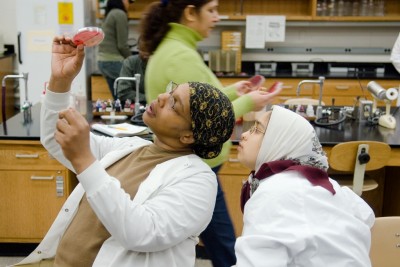By Casey Selix | MinnPost.com
As Normandale Community College in Bloomington, Minn. prepares to host a July 26-29 Technology Engineers Camp for Her (TECH) aimed at sixth- and seventh-grade girls, a new study may help explain why some girls steer clear of STEM fields (Science, Technology, Engineering and Mathematics).
A Miami University team of researchers found that girls may avoid STEM careers because they are “perceived as less likely than careers in other fields to fulfill communal goals (e.g., working with or helping other people),” according to the abstract in Psychological Science, the journal of the Association for Psychological Science.
“Such perceptions might disproportionately affect women’s career decisions, because women tend to endorse communal goals more than men,” according to the team, led by psychologist Amanda Diekman. “We found that STEM careers, relative to other careers, were perceived to impede communal goals.”

(Photo by Ryan Brenizer)
According to a story in Miller-McCune, the team took surveys of 333 introductory psych students, 193 of whom were women. “The undergrads were asked about their career interests, their abilities in different academic areas, and the importance they place on certain personal objectives. Those objectives were divided into ‘agentic goals’ (such as power, recognition, mastery, success) and ‘communal goals’ (helping others, serving humanity, intimacy, spirituality).”
The “more strongly” a participant approved of communal goals, the less likely the participant was interested in a STEM career, the team found, which may help explain why women are represented in greater numbers in the biomedical and psychological sciences.
While looking into the gender wage gap recently, I interviewed Catherine Hill, the national director of research for the American Association of University Women. Biology is the No. 1 science major for women, Hill said. Otherwise, just 5 percent of women want to major in STEM fields, AAUW found.
One of the reasons behind the wage gap is that women tend to work in less-lucrative fields than STEM, researchers have found. Even within the sciences, however, biological science majors make less just out of college than other STEM majors, Hill said. For example, the median salary of female computer information science majors was $83,000 in 2008 compared with $51,000 for biological science majors.
A press release for Normandale’s TECH event reminds us that women represent less than 20 percent of engineering majors and careers. “Our aim is to educate female students about career opportunities in engineering and technology,” according to Nancy Louwagie, program coordinator and Normandale faculty member. “We provide fun, hands-on activities that fuel an interest in pursuing studies in STEM in secondary and post-secondary education — and ultimately a STEM career.” For registration and other information about TECH, contact Nancy Louwagie at nancy.louwagie@normandale.edu.
On a related note: A She’s Geeky “unConference” for women in STEM careers and their daughters also is planned Aug. 6-7 at the Science Museum of Minnesota. Details.
Despite all the efforts to draw more girls into STEM, another study suggests the problem isn’t that the nation isn’t producing enough scientists (female and male), it’s that the nation isn’t producing enough jobs for scientists. Check out Miller-McCune’s story headlined “The Real Science Gap.”
This story is the product of a collaboration between The Hechinger Report and MinnPost.com. It can also be found here on the MinnPost site.



